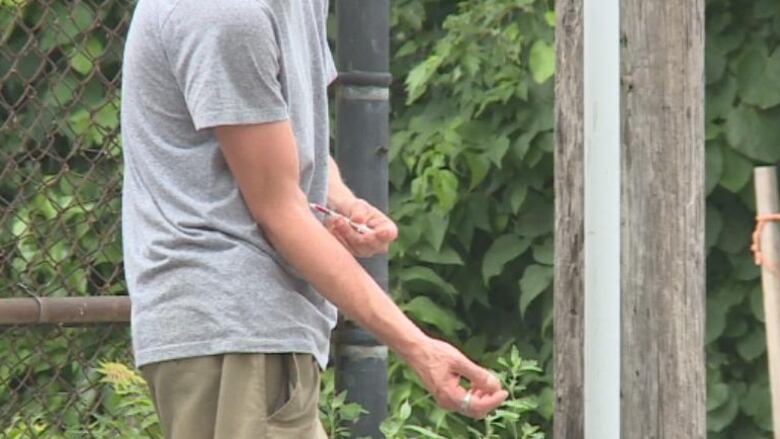Drop in London naloxone distribution during pandemic raises concerns
Naloxone distribution has fallen from 16,000 kits a month to 12,000 after pandemic began

The number of free naloxone kits given out each monthby London region pharmacies has fallen by a third since the coronavirus pandemic began in March, raisingconcerns there could be a corresponding increase in the number of opioid-related deaths, according to an epidemiologist who studies opioid use.
Tara Gomes, a professor of epidemiology at the University of Toronto, isone of the researchers behind the first-ever study to track naloxonedistribution in the province by geographic location.
The study estimates the availability of free naloxone has lowered the rate of opioid-related deaths by anywhere from a quarter to half ever since free kits were introduced by the Ontario government in June of 2016.
The London regionhas one of the highest rates of distribution in the province, but since the pandemic began, Gomes said the number of kits being handed out at London-area pharmacies each month fell by about a quarter.
Number of free kits handed out fell to 400a month

Gomes said the number of free kits in London fell by 33 per cent, from 600 being dispensed at area pharmacies before the coronavirus crisis erupted to 400 afterwards. She noted a quarter drop provincewide, with about 16,000 kits being distributed before the pandemic and 12,000 afterwards.

"There are still kits being dispensed, but that is far lower than in the last year in the London area," she said."The fact we have less naloxone in the community is very concerning."
Gomes said one of the reasons less naloxone is in circulation is because COVID-19 has disrupted everything, from the sweeping shutdowns inthe pandemic's early days, to the current emphasis on physical distancing.
"One of the real concerns are people are more isolated, so they're using drugs more alone. So they might not even be in a circumstance where naloxone can be administered because you need somebody there to administer it."
"We're seeing the number of deaths from opioid overdoses really start to spike post-COVID," Gomes said.
Pandemic sees 25 per cent spike in Ontario overdose deaths

The Middlesex-London Health Unit said recent numbers for opioid-related deaths in London were not available and provincial numbers fromOntario Public Health don't go beyond November 2019.
Numbers for 2020 haven't even been fully counted yet, but so far they'realarming enough.Ontario's coroner has already reported a 25 per cent surge in the number of opioid-related deaths since the coronavirus pandemic began, thanks to a combination of increasingly toxic street drugs and restrictions placed upon outreach workers.
The logic is, the more naloxone is readily available, the fewer opioidoverdose deaths would happen. Up until the pandemic struck in March, the study suggests London was handing out the antidote at one of the highest rates in the provinceat 11.7 kits per 1,000 people, compared to an average of 5.5 provincewide.
The study suggests only 56 per cent of pharmacies in Ontario carry the free kits and Gomes believes, given how common opioid-based painkillers are whethersupplied by a doctor or on the street,more should be done to maximize the reach of the life-saving drug so that naloxone might one day be as common as a first aid kit.
Change starts with pharmacies

"Having a naloxone kit in your house if you are receiving long-term therapy with opioidsis a good thing to do just in case you inadvertently take too much drug or someone else takes your drug without you knowing and experiences an overdose."
Gomes said more needs to be done to reduce the stigma of not just drug addiction, but having a life-saving antidote capable of counteracting their effects. She said it starts with pharmacies, noting that just over half of the pharmacies actually dispense a drug that's supposed to be free.
"We need to put pressure on pharmacies to make this available and that pharmacists be comfortable speaking to the patients that they encounter, whether they're people who use drugs, [either]non-prescribed drugs on the street or people who use opioids to treat chronic pain."
"We need to normalize this," she said. "Make people understand this is something we can all have to just help somebody out if they need it."
Corrections
- A version of this story misstated that a reduction of 200 from 600 was 25 per cent, when it is in fact 33 per cent.Sep 14, 2020 10:48 AM ET
- An earlier version of this story stated that the number of free nalaxone kits being handed out in London fell from 16,000 before the pandemic to 12,000 afterwards, when in fact those numbers are for all of Ontario. In London, the number of free kits being dispensed by pharmacies fell from 600 before the pandemic to 400 afterwards.Sep 14, 2020 7:22 AM ET












_(720p).jpg)


 OFFICIAL HD MUSIC VIDEO.jpg)
.jpg)



























































































